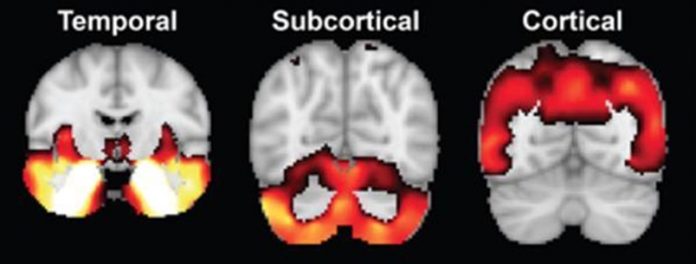
WASHINGTON, Oct. 7 (UPI) — Different atrophy patterns in the brain may be able to explain various ways Alzheimer’s disease can present itself in patients, researchers determined.
The study was conducted by scientists from the Massachusetts General Hospital and the National University of Singapore. Their findings were published online in the Proceedings of the National Academy of Sciences. According to the authors, the neurodegenerative damage associated with the disease manifests itself in a variety of ways previous scholarship has overlooked.
“The symptom severity and neurodegeneration can vary widely across patients in Alzheimer’s disease,” Thomas Yeo said in a press release. “Our work shows that participants in this study exhibit at least three atrophy patterns — cortical, temporal or subcortical — that are associated with variability in cognitive decline not only in patients diagnosed with Alzheimer’s but also in individuals with mild cognitive impairment or those who are cognitively normal but are at risk for Alzheimer’s.”
The research team examined data collected as part of the Alzheimer’s Disease Neuroimaging Initiative, which included blood tests, cerebrospinal fluid tests, and imaging studies. Their sample included 378 participants, 188 of whom were diagnosed with Alzheimer’s disease. The rest were considered to be at risk of developing Alzheimer’s, 147 of whom had mild cognitive impairment and 43 of whom were cognitively normal.
Participants underwent behavioral and cognitive tests at six-month intervals and were scanned again after two years.
Most of the participants were found to have levels of more than one atrophy factor, though behavioral and cognitive tests linked predominant atrophy patterns to particular cognitive deficits. Those with mainly temporal atrophy had greater memory problems while those with cortical atrophy had difficulties with executive function.
“Most previous studies focused on patients already diagnosed, but we were able to establish distinct atrophy patterns not only in diagnosed patients but also in at-risk participants who had mild impairment or were cognitively normal at the outset of the study,” Yeo added. “That is important because the neurodegenerative cascade that leads to Alzheimer’s starts years, possibly decades, before diagnosis.”
The study’s authors say their findings set the stage for future research, which may determine how atrophy patterns may predict the rate of decline for specific cognitive abilities.





